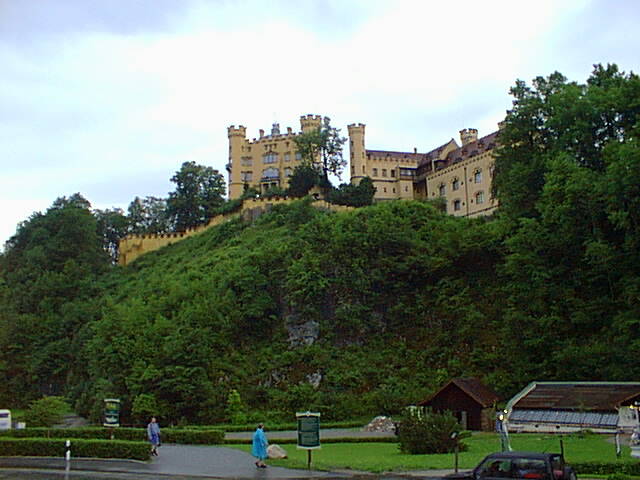
Today we did a fair bit of driving and hiking in the rain, but the destinations were well worth the trouble. As it has done the last couple of days, the weather broke in the afternoon and as I write in the evening I'm seeing lots of blue sky.
Yesterday during our brief tour of Munich our guide told us that there were only five kings of Bavaria, and that they were easy to remember: Maximilian I, Ludwig I, Maximilian II, Ludwig II, and Ludwig III. Maximilian I was set up as king by Napoleon in 1806; the price was high, though: Bavaria had to contribute 35,000 soldiers to Napoleon's campaigns, and only 5000 made it home. Ludwig I, the next king, was not nearly so fond of Napoleon, and as he beautified the city of Munich he named some major streets after battles between the Germans and French. I mentioned yesterday that I had spent three months in Munich five years ago; one thing that puzzled me was all the Greek- and Italian-looking architecture, and the Greek names (Pinakothek, Glyptothek) on some museums. According to our guide yesterday, this is due to Ludwig I, who wanted Munich to be a center of high culture like Athens and Florence. Munich is sometimes referred to as "the northernmost Italian city" because of all its fountains! It was his grandson Ludwig II, however, who left the architectural legacy which most of us associate with Bavarian royalty.
Our first destination was the town of Schwangau, in the foothills of the Alps. This is along the "Romantic Road", a sequence of major roads actually, which takes a visitor to many of the famous castles of Germany. Just above the town is the palace of Hohenschwangau, where Ludwig II spent a lot of time when he was growing up.

Nice as this place might seem, it wasn't good enough for Ludwig II, who had an exaggerated romantic sensibility; he ordered built a number of palaces now famous throughout the world. Not far off our path today are Linderhof and Herrenchiemsee, and I spent a lot of sunny hours in Nymphenburg on the outskirts of Munich when I was here five years ago. By far the most famous, however, is Neuschwanstein, which we visited today.
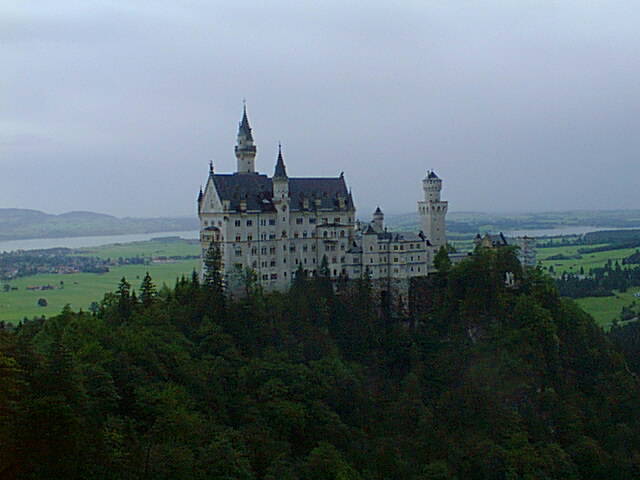
No, this isn't a helicopter shot; there's a rather narrow bridge over a deep gorge behind the castle, and I overcame my acrophobia long enough to step out onto it and get this photograph. Five years ago I wanted to visit this place, just to confirm for myself that it was real and not just a figment of Walt Disney's imagination; I ran out of time then, but I walked through it today and can attest to its reality! The interior is decorated lavishly, mostly with themes from the operas of Ludwig II's friend Richard Wagner; regrettably, they didn't allow photography inside, so I can't show you here. The outside was designed not by an architect, but by one of the painters who did the interior; this doubtless contributed to its fantastical shape. It's too bad that, as Ludwig II died at the age of 40 (under mysterious circumstances--he and his doctor were found drowned, and whether it was accident, suicide or murder has never been settled), he only got the chance to spend a few months here.
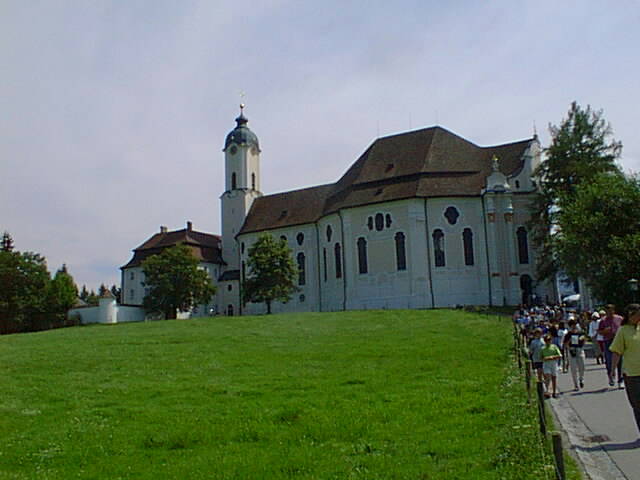
Then we drove a short distance to the Wieskirche. This is another fantastical structure, not from the outside particularly (as you can see from the above photo), but rather in its baroque-with-elements-of-rococo interior.
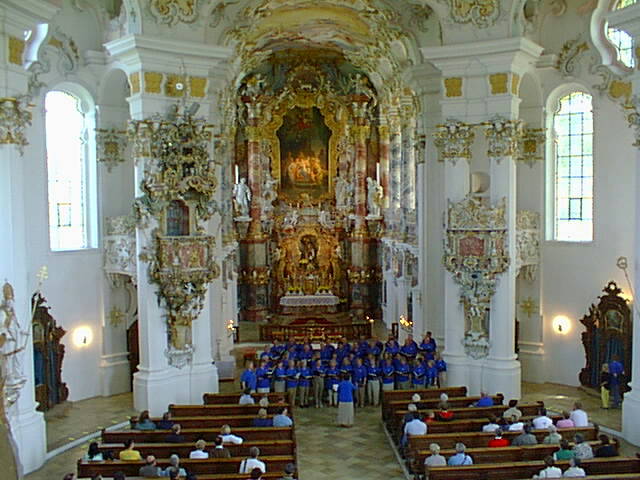
We sang a half-hour informal concert, our last of the tour, inside this church; there were a lot more audience members behind the last pews visible in this photo (shot by Jim Belt from the balcony using my camera--thanks!). The church is situated right on a farm, on the site of a small shrine set up for a statue of Jesus that was rescued from a monastery attic. In 1738 there were reports of tears in the eyes of the statue, and the location became a major pilgrimage site; eventually the offerings brought by pilgrims added up to enough to build this large and ornate church.
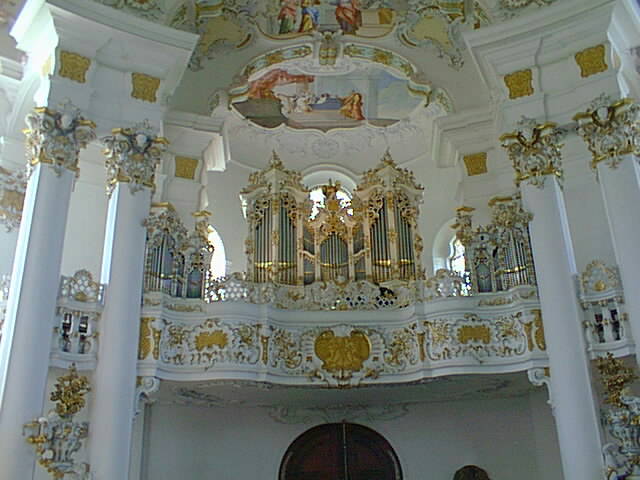
This is a view in the other direction, toward the organ on the balcony; we sang our a capella songs, because we didn't have time to work out how to synchronize the organ above and the choir below, but then Lee Lasseter played a postlude on this organ. This photo shows how the white and gold color scheme of most of the church, combined with the uncolored windows (now that the sun had come out!), makes the interior of this church feel very open and airy despite being heavily decorated.
After we returned to Munich from our final concert, the group headed off to the famous Hofbräuhaus for a farewell dinner and a folkloric show. They are enjoying that as I type; I decided I didn't want to face the noise and crowds tonight (not that I ever do), and besides I wanted to finish up the website and get as much sleep as possible to assist in the transistion across nine time zones tomorrow. Since this is the last time I will connect to the Internet before we return home tomorrow, I have removed all the e-mail links on the website; please don't send any more e-mail to other members of the group c/o "Mr. Gasser", as they won't be around my computer to receive them. Thanks to all who did send e-mail during the trip, though; the members of our group very much appreciated your making the effort to stay in touch with them!
We had several additional family and friends as guests for this last day before the close of our tour. Joanna Gable, Phil Flad's cousin from Tampa, joined the Flads today in order to head off to Stuttgart after the tour to research some family roots. Susanne Hatlie, the daughter-in-law of Judy and Guy Hatlie, and her mother Roselinde Scheible came from Tübingen to see us. Finally, Bob and Carol Jones of our own MBCC family met us at the Wieskirche, having come from the Netherlands where they were on vacation!
To conclude this journal of the 1999 European Tour of the Manhattan Beach Community Church Senior Choir, let me to quote again from one of our songs, which in turn quotes Psalm 115:1. We have received a lot of applause on this trip; I think the most unexpected was after the service last Sunday in the church of St. Gilgen: after all, these were not tourists who happened upon us as we were singing, but regular parishioners in what appeared to be a fairly traditional church. But while we certainly enjoy applause, especially the large fraction of us who have a theatrical bent, the reason a church choir sings is not for our own renown, but to help bring others (and ourselves!) closer to God. So, "Non nobis, Domine, sed nomine tuo da gloriam": not to us, O Lord, but to Your Name be the glory!
Amen.
 Back
to choir tour itinerary
Back
to choir tour itinerary Back
to choir tour home page
Back
to choir tour home pagenew 13 July 1999